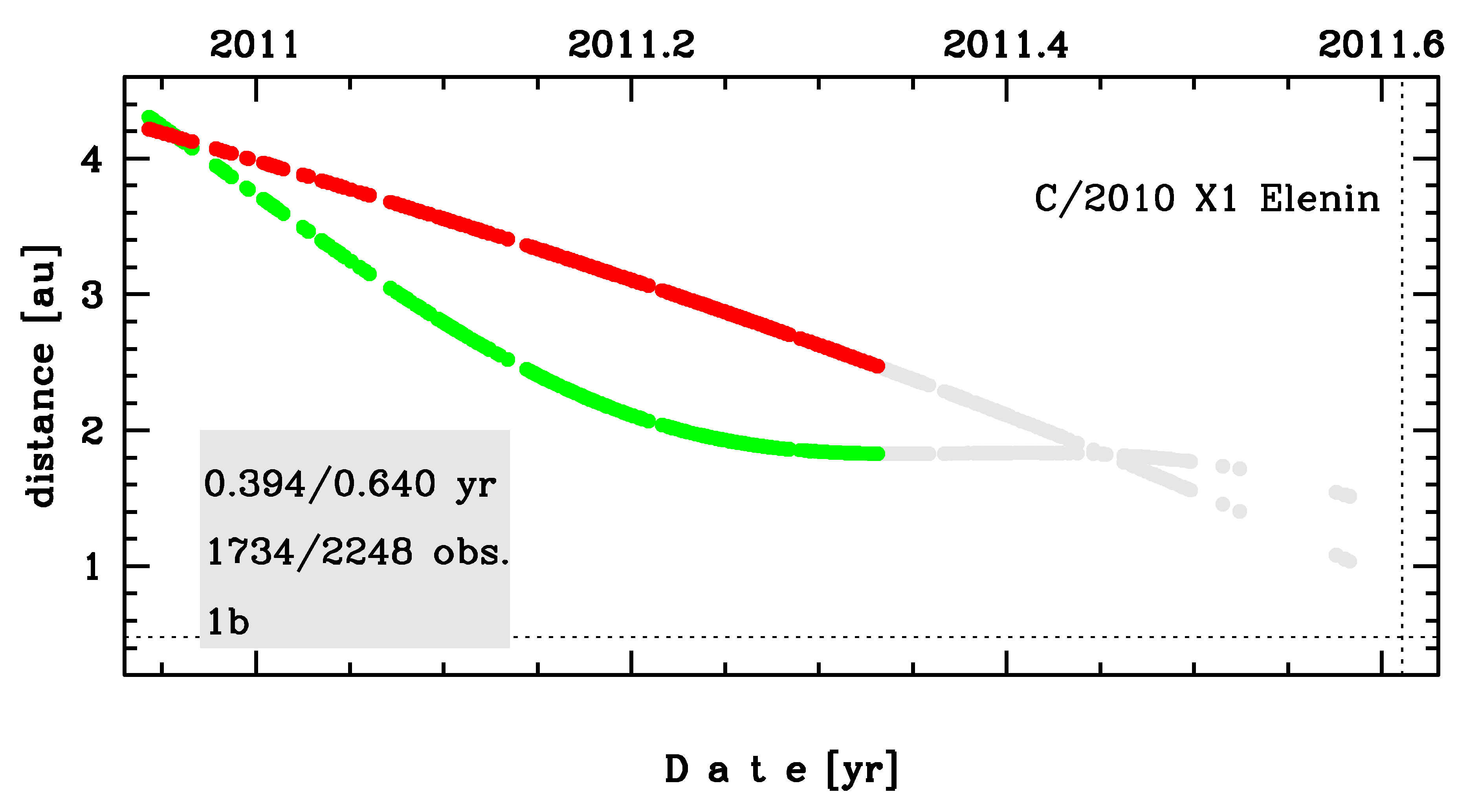C/2010 X1 Elenin
more info
Comet C/2010 X1 was discovered on 10 December 2010 by Leonid Elenin (Lyubertsy, Russia); that is about 9 months before its perihelion passage. This comet was observed until 1 September 2011; however it started to disintegrate in August.
The deepest approach to the Earth would be on 16 October 2011 (0.233 au), about a month after its perihelion passage.
The solution based on observations taken to the end of July/June/May exhibits some trends in O-C time variation. Therefore, the preferred solution given here is based on data taken before 1 May and spanning over 0.394 yr in a range of heliocentric distances from 4.22 auto 2.47 au.
This was an Oort spike comet.
See also Królikowska and Dybczyński 2013, Sekanina 2019, and Królikowska 2020.
The deepest approach to the Earth would be on 16 October 2011 (0.233 au), about a month after its perihelion passage.
The solution based on observations taken to the end of July/June/May exhibits some trends in O-C time variation. Therefore, the preferred solution given here is based on data taken before 1 May and spanning over 0.394 yr in a range of heliocentric distances from 4.22 auto 2.47 au.
This was an Oort spike comet.
See also Królikowska and Dybczyński 2013, Sekanina 2019, and Królikowska 2020.
| solution description | ||
|---|---|---|
| number of observations | 1734 | |
| data interval | 2010 12 10 – 2011 04 30 | |
| data arc selection | data generally limited to pre-perihelion (PRE) | |
| range of heliocentric distances | 4.22 au – 2.47au | |
| detectability of NG effects in the comet's motion | comet lost close to perihelion or split comet | |
| type of model of motion | GR - gravitational orbit | |
| data weighting | YES | |
| number of residuals | 4135 | |
| RMS [arcseconds] | 0.46 | |
| orbit quality class | 1b | |
| previous orbit statistics, both Galactic and stellar perturbations were taken into account | ||
|---|---|---|
| no. of returning VCs in the swarm | 4974 | * |
| no. of escaping VCs in the swarm | 27 | |
| no. of hyperbolas among escaping VCs in the swarm | 0 | |
| previous reciprocal semi-major axis [10-6 au-1] | 21.19 – 26.17 – 31.47 | R |
| previous perihelion distance [au] | 394 – 723 – 783 | R |
| previous aphelion distance [103 au] | 63 – 76 – 94 | R |
| time interval to previous perihelion [Myr] | 5.6 – 7.3 – 9.9 | R |
| percentage of VCs with qprev > 20 | 100 | |
| previous_g orbit statistics, here only the Galactic tide has been included | ||
|---|---|---|
| no. of returning VCs in the swarm | 4987 | * |
| no. of escaping VCs in the swarm | 14 | |
| no. of hyperbolas among escaping VCs in the swarm | 0 | |
| previous reciprocal semi-major axis [10-6 au-1] | 22.28 – 27.28 – 32.26 | R |
| previous perihelion distance [au] | 24 – 67 – 240 | R |
| previous aphelion distance [103 au] | 62 – 73 – 90 | R |
| time interval to previous perihelion [Myr] | 5.4 – 6.9 – 9.3 | R |
| percentage of VCs with qprev < 10 | 1 | |
| percentage of VCs with 10 < qprev < 20 | 6 | |
| percentage of VCs with qprev > 20 | 93 | |
